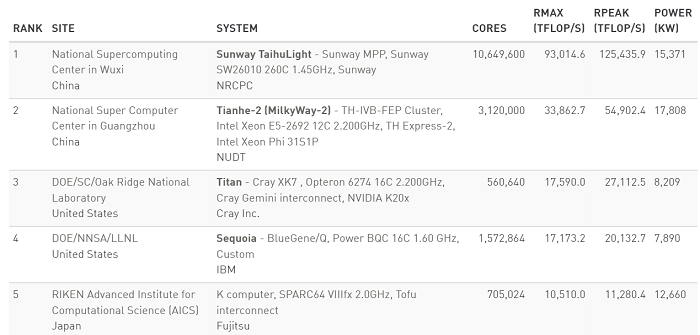中國超級電腦「神威太湖之光」躍居全球速度最快的超級電腦,不僅是首台完全採用中國晶片的超級電腦,也是中國在超級電腦 500 強的入圍數量首次超越美國。

(圖說:中國超級電腦「神威太湖之光」。圖片來源:top500.org)
全中國生產超級電腦、排名數量首度超越美國
超級電腦排名由研究組織 TOP500 每隔兩年推出,神威內含超過1千萬顆核心處理器,計算速度每秒可達 93 千億次(petaflop),較上一屆冠軍天河二號快近 3 倍、美國最快的超級電腦快 5 倍。此外,神威在單位計算功耗的表現也較其他超級電腦高3倍,每瓦可達6億次。
排行榜主要撰寫人、美國田納西大學電腦學教授唐加拉(Jack Dongarra)指出,神威是第一步採全中國製造零件的超級電腦,在此之前的冠軍天河雖然為中國廠商,但使用美國的Intel處理器,在這次報告排名第二。
此外,這也是中國首次在超級電腦入圍數量超越美國,2001年中國還沒有任何一台機器入圍,但在最新的報告中,中國入圍167台,美國則以165台微幅落後,日本以29台的入圍數排名第三,台灣則榜上無名。
中國受政府、美國、市場驅動發展超級電腦
《IBTimes》分析中國超級電腦發展迅速原因,歸納三點。首先,中國政府希望可以降低對海外技術、尤其是對美國的依賴,因此砸下大量經費在研究和開發超級電腦,研發自有技術。
除了內部驅動力,中國科技產業也受到美國政府在2015年禁止高階處理器(如Intel的多核心協同處理器Xeon Phi)銷往中國,雖然沒有明訂禁運對象,但只要可能是對美國的國家安全或外交政策利益構成風險,就應被禁止。
此外,儘管超級電腦晶片的市場並不普及,但一般電腦晶片的市場需求卻相當龐大,藉由拉抬超級電腦處理速度,中國廠商可展現其有和現有晶片供應商如IBM和Intel的晶片製作能力,鞏固在晶片市場的地位。
除此之外,不論對美國或中國,超級電腦是科學和國防發展的關鍵,過去被政府用在破解密碼、核能武器開發,對一般民眾而言則可提供氣象預報、石油探勘和汽車設計。
速度難客觀判斷,受測試基準影響
不過唐加拉指出,這些機器不一定可用來運行典型超級電腦的一般任務,而是特別為入圍排名製作的機器,很難對超級電腦性能做出客觀判斷。
此外,受到速度計算方式的限制,排名也不定能真實反應電腦性能。唐加拉指出,該排名的評估標準為超級電腦計算基準Linpack,儘管神威跑Linpack時相當快速,較天河快3倍,然而當以另一套計算基準HPCG( High Performance Conjugate Gradients )運作時,神威的運作效率卻僅為其他超級電腦的四分之一,在需要大量內存記憶體的應用(如移動資料)上表現較差。
每年6月及11月均會更新全球500強超級電腦排名的「TOP500」計劃,近日公佈最新結果。3年前開始成為榜首的中國超級電腦「天河二號」,被同樣來自中國的「神威太湖之光」取而代之。此外,中國在榜上的超級電腦有168部,以3部之差首次超越美國,日本跟以29部排第3。
位於中國國家超級計算無錫中心的神威太湖之光,使用40,960個260核心處理器——每個處理器有256個核心作運算用途,餘下4個用作資源管理。這使得整部超級電腦擁有超過千萬核心,比天河二號的312萬還要多,同時耗電量卻低了超過13%。
兩部超級電腦使用的晶片亦有所不同,天河二號使用半導體業巨頭英特爾的處理器,而神威太湖之光則用中國自家開發的晶片SW26010。這亦使得神威太湖之光成為首部登上榜首的中國製超級電腦,成為中國科技發展的里程碑。
China Races Ahead in TOP500 Supercomputer List, Ending US Supremacy
Michael Feldman, June 20, 2016, 9:58 a.m.
US supercomputing was dealt a couple of blows on Monday after the latest rankings of the 500 fastest supercomputers in the world were announced during the opening to the International Supercomputing Conference (ISC). In the updated TOP500 list, China retained its leadership at the top with a new number one system, while also overtaking the United States in the number of total systems and aggregate performance. This is first time in the list’s history that the US did not dominate the TOP500 results in these latter two categories.
The new top supercomputer, known as Sunway TaihuLight, achieved a world-leading 93 petaflops on the Linpack benchmark (out of 125 peak petaflops). The system, which is almost exclusively based technology developed in China, is installed at the National Supercomputing Center in Wuxi, and represents more performance than the next five most powerful systems on the list combined. TaihuLight beats out its older cousin, Tianhe-2, a 33-petaflop machine running at the National Super Computer Center in Guangzhou, and which was the top-ranked supercomputer since June 2013. For a deeper look at TaihuLight, see our extended coverage here.

Besides the being tops in performance, China now leads in sheer numbers well. Although the country took the system lead away from the US, the two superpowers are on nearly the same footing in this regard: China has 167 systems, the US has 165. But considering that just 10 years ago, China claimed a mere 28 systems on the list, with none ranked in the top 30, the nation has come further and faster than any other country in the history of supercomputing.
Everyone other country is much further back. In the latest rankings, Japan has 29 systems, followed by Germany with 26, France with 18, and the UK with 12. No other nation claims more than 10 systems on the list.
It should be noted that the surge in Chinese systems was achieved with the help of number of generically named Internet service providers and a number of anonymous commercial firms that ran Linpack on their in-house clusters. It’s likely that a good number of these systems don’t actually run what would be considered HPC workloads during their day jobs, so their presence on the list has probably inflated China’s representation to some degree. For what it’s worth though, the US and other countries also claim a number of these questionable HPC machines, so it’s difficult to make objective comparisons.
With this latest list, the aggregate performance of all 500 machines is more than half an exaflop, 566.7 petaflops to be exact. Of that total, the number one and two machines from China represent 126.9 petaflops, or nearly a quarter of the total. As a result, China captured the TOP500 performance lead from the US for the first time.
Vendor share in supercomputing reflects the usual suspects: Cray leads in installed performance, with about 20 percent of total; Hewlett Packard Enterprise is tops in total number of systems, with 127; and Intel totally dominates other chipmakers in systems using their processors, with 455. The majority of accelerator-equipped systems are powered by NVIDIA GPUs (67 systems) and Intel Xeon Phi processors (26 systems), but the total number of accelerated supercomputers declined from 104 to 93 since the last list in November 2015.
Despite all the new Chinese systems, turnover on the list continues to be sluggish. The top 10 list is unchanged, save for the new number one, which bumped all the other systems down a notch. The rest of the list followed that general trend, resulting in a slower rate of performance growth that started back in 2008. Prior that that year, aggregate supercomputer performance was increasing at around 90 percent per year; after 2008, it flattened out to 55 percent per year. If TaihuLight hadn’t been submitted this time around, the aggregate performance would have barely budged at all since last November.
There are myriad of theories out there that try to explain the lagging growth rate: Moore’s Law is slowing down (maybe slightly, but not nearly enough to account for the lesser growth); the global recession has killed government spending (that’s essentially over); and there’s less interest in reporting their machines (doubtful, that goes against human nature).
The best hint is that the increase in the size of the systems, that is, the number of server nodes, is on the decline – not in absolute numbers, just the rate of growth. That suggest that users are less willing to pay for larger systems. While Moore’s Law essentially gives you a free ride to more performance, adding extra servers and the network to connect them, not to mention the power to run them, costs real money.
Conventional wisdom says that HPC users have insatiable demand for performance, but they must still quantify that demand with cost/benefit considerations. The slowdown in system size suggests that the cost/benefit ratio is getting larger. Adding accelerators can give you better performance without increasing system size, but the slow rate of adoption indicates that the ancillary costs of moving to accelerators is slowing their uptake.
Finding the trend lines of growth in system size growth is complicated by the fact the top end of the list, made up primarily of capability supercomputers that serve large research communities, are used very differently (and procured very differently) than most of the systems in the remainder of the list, which are smaller machines used to run a defined set of well-worn applications.
Overall though, the slowing growth rate points to a maturation of the HPC user community. That’s not a bad thing in itself, but will lead the users and vendors down a different path if the trend continues. There’s sure to be more talk this week at ISC about how supercomputing growth is evolving. Stay tuned for more coverage on this topic.



 留言列表
留言列表



